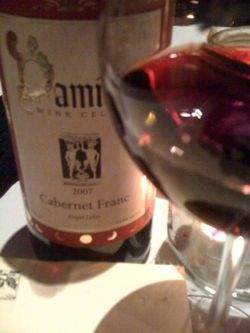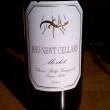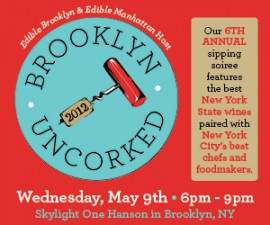A Magical Finger Lakes Red, and Why it’s Gone Too Soon
 It had been two years since I last tasted the Damiani Wine Cellars 2007 Cabernet Franc, and I was down to my last bottle. On release, it was an impressive wine with depth, if a tad besmirched by oak. I liked it enough to buy three bottles.
It had been two years since I last tasted the Damiani Wine Cellars 2007 Cabernet Franc, and I was down to my last bottle. On release, it was an impressive wine with depth, if a tad besmirched by oak. I liked it enough to buy three bottles.
Earlier this month my wife and I went to dinner and decided to open this wine one more time.
Sometimes we talk about transformation that can occur in a complex wine, but no one really knows what to expect. If I harbored high hopes for the Damiani Cab Franc, it turns out those hopes were decidedly too low.
This wine was an absolute beauty, complex, layered, structured. It had gone from a pony to a wild stallion, from a Dodge Neon to an A8.
“That’s too bad,” I said, not disappointed in the wine by any stretch, but saddened at the thought that most of it was already sold and drunk.
This wine was released in 2009 when the components, while impressive, were still stitching themselves together. Imagine stopping by the automaker’s shop; the parts on the factory line appear built for power and elegance, but you can’t quite tell how it will come off as a finished product.
There’s no reason to doubt anymore. Damiani’s 2007 Cabernet Franc is simultaneously strong and graceful. It’s not a powerhouse on the scale of a warm climate wine, and it’s not meant to be. But it’s simply packed, a layered wine that peels off a new aroma and flavor every few seconds.
So why was it released so young? In that regard, there is nothing unique about this wine. Out of necessity, Finger Lakes wineries often release wines younger than they’d prefer to, whether it’s a riesling, a sparkling wine, or reds from warmer vintages (and 2007 was one of the special red wine vintages the region has ever seen). Margins are slim around here, and when a vintage sells out, often wineries need to put the next vintage on the shelf simply to keep cash flowing.
I asked Damiani co-owner Glenn Allen if that was the case with the 2007 Cabernet Franc.
“Yes,” he replied. “Often it is the case that a wine released early is just a few months away from being sufficiently open to enjoy it as a young wine.”
But Allen feels that the recent warmer vintages (2007 and 2010) have produced wines capable of opening up shortly after bottling. “There are many who like or prefer their wines young, full of bright fruit and vibrant tannins, so it’s always debatable when is the best time to release a wine,” he explained. “Especially with the 2007 vintage, releasing them early was not so much of a regret.”
Production was relatively low for many Finger Lakes wineries in 2007, and that’s true for Damiani as well. The result is a wine that disappeared rather quickly. Fortunately, Damiani is beginning to build a library, including seven cases of the 2007 Cab Franc.
“We’re trying to library more of our age-worthy wines from each vintage,” Allen said, adding that this practice is “both for our personal cellars and for re-releasing to our wine club members. We also now pour some samples of library wines at our tasting room, using a wine preservation system that keeps the wine intact.” Most recently, Damiani’s tasting room featured its 2004 red wines.
Allen guessed that the ’07 Cab Franc would peak at five years old, cruising right along for another five. That means that it is only now approaching its prime. What a shame that most of this wine was gone before customers could see it rise to its current height.
And where does it go next? As we’ve written about previously, no one can say with certainty, but that’s part of the fun. Damiani will have to decide carefully when to release its remaining bottles.
How to change the trend that sees so many wines released so young? Allen said it starts with educating customers about wine’s potential. “I always let people know that a young wine will become even better if they lay it down for awhile,” he said. “If they buy a few different wines, say including some whites, I suggest to them that they drink the young wine last.”
But so often, wines are released according to financial needs of the winery. No one should knock a winery for this practice if it’s truly a matter of economic necessity. I’ve spoken to countless winemakers and winery owners who wish they could wait a while with a special riesling or a structured red. But bills have to be paid, and for those of us who are only consuming the wines and not financing its creation, it’s easy to criticize. Better to remind winery owners, gently, that building a library - when feasible - is a wonderful idea. Exhibit A is Damiani’s 2007 Cabernet Franc, if you can find it.

















I always value the posts you guys write about aged NY wines. The posts are interesting and give me useful guidance. In this case, alas, I got to Damiani too late in the summer and they had already sold out the 2007 Cab Franc. But I do still have a Ravines and a couple Shalestone Cab Francs from 2007 that I’m now even more eager to drink.
I definitely do not criticize wineries for releasing early. For one thing, I believe the onus falls just as much on the consumer. If we want to see what these wines taste like after some time, then it’s our job to cellar them. For another, seeing how a young wine develops is part of the fun. I love stopping at Shaw and tasting wines that have been given longer to develop, but if the majority of FLX wineries followed that model, I think I’d be a little sad. I enjoy guessing at young wines’ potential. This will occasionally result in disappointment, but there can be pleasant surprises, too. Compared to other wines in the vintage, Dr. Frank’s 2007 Cab Franc struck me as middling upon its release (and so did NYCR), but when I opened a bottle of it a few months back it drank very nicely. Drinking it felt like my reward for waiting and seeing. If most wineries waited longer to release their wines, it would offer more clarity, but would I enjoy drinking the wines as much later? Probably not.
Ryan - You and I are on the exact same page regarding how long to hold wines. We’re willing to let it go too far. We’re willing to find out what “over the hill” means. We know that a wine that is “a little tired” is still telling us something interesting. And we’re not obsessed with making sure we get to the wine before it begins to “go downhill.”
Funny you mention the Dr. Frank Cab Franc; the last time I had that wine was New Year’s Eve, 2008. It was almost mute, saying very little. Nice to hear it’s found its voice.
And man, you’re so right about the role of the consumer. It’s not always a financial decision. Wineries need to know that people are interested in their wines with a touch of maturity. We’re a region of precocious toddlers, snatched up before adolescence.
Doesn’t Shaw sell older wines because a) They keep wine in barrel forever and b) They can’t sell them faster?
Good points, Evan. I do wish that more of the top-tier Finger Lakes wineries held on to their wines longer (like in Europe). Even the better California wineries hold on to their best stuff for more than 12 months.
I’m crossing my fingers that Damiani, Ravines, Red Newt, Wiemer, and more hold on to their vintages longer and longer…don’t you think there’s been some slightly longer delays in the last few years, or am I crazy?
Shaw is the only one, as far as I know, that tries to buck the economic pressures. Upstate Ian sounds like one of those winery owners you allude to who gives more consideration to his bank than he does to his customers. Jealous?
Interesting post Evan, I too recently enjoyed a bottle of that same Damiani Cabernet Franc, it was drinking beautifully. As you point out, holding wines until they have had a chance to hit their stride is both difficult and expensive. But the reward for doing so can be quite an experience.
I think it is also important to note that like the Damiani Cabernet Franc, elegant age worthy wine comes almost exclusively from the best growers and vineyards. That is critical.
I know that our aged Shaw Wines are not for everyone, but for those kind enough to have stopped at our tasting room to give them a try, we find most of our visitors have enjoyed them enough to take some home.
So whether you prefer to age wines in your own cellars or indulge in the older library style vintages, we feel the Finger Lakes is a good place to produce these soft, complex, truly food friendly wines.
Heads-up on an a brilliant age worthy Damiani wine…2010 Syrah Reserve…shhh, don’t tell EVERYONE, they only made 71 cs and I want to make sure I get mine.
For the winery to hang on to wines is definitely expensive, but there is a factor that is even more important. Distributors, retailers and most of their customers want fresh product. If most of the Cabs in the shop are ’09s, then ’07s and ’08s get passed over as not fresh. The businesses in the supply chain don’t want to be stuck with a lot of “unfresh” product just because a few folks appreciate these.
Ryan up top is absolutely right, the lover of mature long-lived wine has the responsibility for finding the likely candidates on release and cellaring them. Besides, taking responsibility for aging adds to the delight of drinking them at their peak.